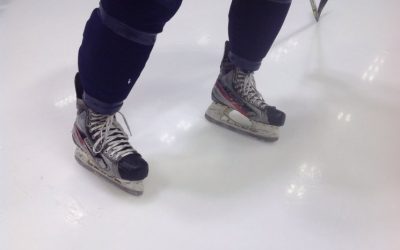Why aren’t field hockey players necessarily good descenders?
Many field hockey players have tried their hand at Ice Cross Downhill, believing that being one of the fastest on their team would guarantee them success in their new sport. While some were successful, the majority failed to reach their performance targets. So why is skating on an ice rink so different from skating downhill? Once again, science helps us to explain this. The main elements of this difference are the technical aspects of the sport, the coordination between eye and movement, and the physical demands.
In an Ice Cross Downhill race, the aim is to complete the course as quickly as possible and reach the finish line first. To do this, athletes have to pump (absorb the bump followed by a push after it) and jump the bumps and jumps on the course. The ability to control the moment spent in the air is the key to success in jumps, while the ability to pump bumps allows you to accelerate through obstacles rather than lose speed. These two techniques are a far cry from those learned by field hockey players, and are much closer to those used in downhill sports such as alpine skiing or mountain biking. In the same vein, the choice of the ideal racing line is also an essential element of performance, to ensure that speed is maintained when cornering and rounding obstacles. In field hockey, there are no jumps or bumps. The ice is flat and predictable. The only way to increase speed is to increase the power of your skating strokes.
The superior speed achieved in Ice Cross Downhill is due to the steep slopes in which the tracks are built, making it the fastest skate sport in the world. Athletes regularly reach speeds in excess of 60 km/h. At this speed, the perception of the body in space is not the same. The biggest difference lies in the amount of sensory information that needs to be analyzed by the eyes. The faster-moving environment demands a speed of information processing that exceeds the capacity of individuals who are not trained for it, such as field hockey players. These visual integration problems can go so far as to create discomfort (such as dizziness) caused by too much visual information to process in a short period of time. This element is far from being part of field hockey players’ daily lives, whereas it is very common for athletes from speed sports.
Physical demands are another element that diverges between field hockey and Ice Cross Downhill. Apart from the obvious fact that Ice Cross Downhill requires greater absorption capacity to control the landing of the many jumps, the two sports have very distinct skating biomechanics. On a field hockey rink, the thrust must counteract the friction of the skate blade on the ice, resulting in a slower thrust that is much more focused on the player’s strength. During a descent, gravity allows the player to pick up speed, and the thrust becomes much more focused on the speed of muscle contraction than on muscle strength. This type of neuromuscular quality is rarely predominant in field hockey players, who train much more for strength and power.
In conclusion, being a skate-fast field hockey player is no guarantee of success in Ice Cross Downhill. Field hockey players need to learn how to be in control in the air, as well as how to absorb and jump over obstacles. They need to develop the coordination between eye and movement that is specific to the discipline in order to be more efficient at analyzing a lot of visual information quickly. Their ability to produce a fast rather than strong muscle contraction will also need to be improved if they are to perform well in this new sport. In short, field hockey players don’t necessarily possess all the qualities required of an Ice Cross Downhill athlete. If so, what would be the best sporting baggage?
Written by Léandre Gagné Lemieux, M.Sc. kinesiology and Ice Cross Downhill athlete
References
1. Bronstein AM (2004) Vision and vertigo: Some visual aspect of vestibular disorders. J Neurol. 251:381-387.
Want to stay on top of new articles before they’re published?
Subscribe to our newsletter.
From the same author
Why is it easier to turn left?
Why is it easier to turn left? MAXIME Sports physiotherapist In a field hockey match, various skating techniques are used to counter the opponent. A technique of choice for quickly changing direction while maintaining good speed is the sharp turn. On the one hand,...

